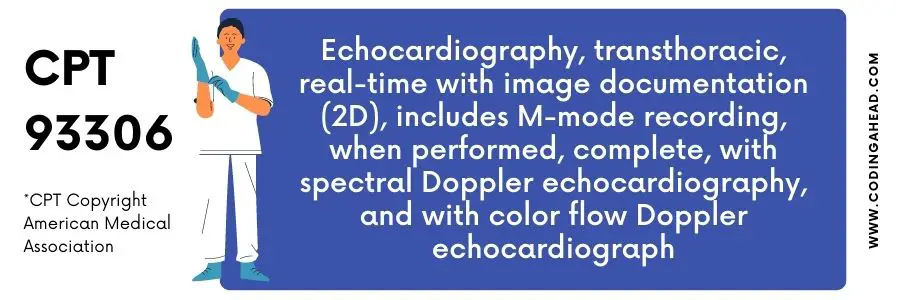93306 CPT Code (2023) Description, Guidelines, Reimbursement, Modifiers & Example
93306 CPT code can be billed for echocardiography procedures. Transducers affixed to the chest wall can generate two-dimensional (2D) images of the heart’s architecture. This CPT code investigates the structural integrity of the four heart chambers and how they interact.
Summary
This service has both a professional and a technical component. Echocardiography that includes doppler and color flow in addition to the standard transthoracic echo is known as doppler echocardiography.
The numeric error code is 93306 CPT code. The trans-thoracic ultrasonography procedure includes spectral Doppler echocardiography, color flow, and real-time picture documentation (2D). An M-mode exam may recommend, although it is not required to assign a whole echo code.)
The report must explain why photographing all of the listed structures is impossible. Limited transthoracic echocardiography may pay to analyze or evaluate the systems described above.
Little research often focuses on a specific clinical issue or is a follow-up to a previous study. Unlike a transthoracic echo, the echo equipment may link to an endoscope and be inserted into the esophagus to get a clearer view of the heart.
There are instances when standard transthoracic echo results are insufficient to resolve a clinical question or when a doctor wishes to examine the heart in greater detail. Two-dimensional images of the heart’s interior characteristics can be seen and captured (cardiac chambers, valves, and prominent veins).
CPT 93325 may pay in addition to restricted echocardiography if medical need and color Doppler findings are validated (CPT 93308). Spectral Doppler imaging includes pulse-wave, continuous-wave, and tissue Doppler imaging, each with its CPT code.
Diastolic function, right ventricular performance, and valve stenosis will measure. CPT 93321 may bill for spectral Doppler imaging with limited spectral doppler imaging. The codes 93303-93304 and 93315-93317 will use if congenital heart disease is suspected but not found after an echocardiographic assessment.
In these circumstances, non-congenital echocardiography codes may also use.
When an echocardiogram reveals no evidence of congenital cardiac disease, avoid using the codes 93303-93304 and 93315-93317. Codes for non-congenital echocardiography may use in these situations. The use of echocardiography for purposes other than gathering diagnostic or monitoring data will not encourage.
93306 CPT Code | Description
CPT 93306 can be reported for echocardiography which is an ultrasonic examination of the heart. It is a popular noninvasive technique for assessing heart anatomy and function.
A Doppler examination is a helpful supplement to an echocardiographic examination because it enables for the assessment of the presence and severity of valve stenosis, valvular regurgitation, and ventricular dysfunction of cardiac output, intra-cardiac pressures, and intra-cardiac shunts.
Echocardiography could be complete or limited. Coders who bill CPT 93306 should verify the documentation to confirm complete or limited to avoid any upcoding or downcoding.
CPT 93306 is described as:
Echocardiography;
- transthoracic;
- complete;
- real-time with image documentation (2D);
- includes M-mode recording when performed with spectral Doppler echocardiography and with color flow Doppler echocardiography.
To bill the 93306 CPT as transthoracic echocardiogram the following requirements need to be met:
2-dimensional and (when performed) selected M-mode examination of the:
- left and right ventricles;
- mitral and tricuspid valves;
- the aortic;
- the pericardium and adjacent portions of the aorta; and
- the left and right atria.
A complete echo code is not required in order to assign while M-mode exam is usually performed.
The report must indicate the reason because it is impossible to image all of the listed structures
The 93308 CPT code does qualify if a limited transthoracic echocardiogram is done. If the report does not evaluate or attempt to evaluate all of the structures listed above.

CPT Code 93306 vs 93307 vs 93308
When a repeat comprehensive echocardiographic examination is unnecessary owing to a more targeted clinical issue, this is often conducted during a follow-up of a complete echocardiographic examination.
CPT code 93308 can be reported as a follow-up study to the 93306 CPT code or the 93307 CPT code, or as a stand-alone code.
In some emergent clinical scenarios, a limited echocardiographic study may be performed primarily. It should be noted that all three of these echocardiographic services necessitate image documentation.
Reimbursement & Billing Guidelines
CPT 93306 includes Doppler and color flow (2-D and M-mode). Therefor CPT codes 93320-93325 should not be assigned together with the 93306 CPT code.
CPT 93306 excludes transthoracic without spectral and color Doppler. Report the 93307 CPT code for a complete evaluation but without spectral or color flow Doppler and report 93308 CPT code for a follow-up or limited study.
A complete echo is reported with CPT 93306 if no congenital issue is discovered. It is eligible to code echocardiocarghy with modifier 26 (professional component) and Modifier TC (technical component).
Place Of Service
If cardiologist is interpreting for the hospital, the place of service for CPT 93306 is:
- POS 21 (Inpatient Hospital);
- Pos 22 (On Campus-Outpatient Hospital); or
- POS 23 (Emergency Room – Hospital).
Medical Necessity And ICD 10
The ICD 10 CM codes that support medical necessity and provide limited coverage for 93306 CPT code.
It is the provider’s responsibility to select codes carried out to the highest level of specificity and selected from the ICD 10 CM appropriate to the year in which the service is rendered. Transthoracic Echocardiograph ICD 10 CM supports medical necessity for the 93306 CPT code.
Echocardiography is indicated in the evaluation of derangements of valvular, myocardial and pericardial function. Therefor it is considered medical necessary in the following cases:
- Native Valvular Heart Disease
- Prosthetic Heart Valves (Mechanical and Bio-prostheses)
- Endocarditis
- Ventricular Function and Cardiomyopathies
- Acute Myocardial Infarction and Coronary Insufficiency
- Hypertensive Cardiovascular Disease
- Cardiac Transplant and Rejection Monitoring
- Exposure to Cardiotoxic Agents (Chemotherapeutic and External)
- Pericardial Disease
- Congenital Heart Disease
- Cardiac Tumors and Masses
- Critically Ill and Trauma Patients
- Suspected Cardiac Thrombi and Embolic Sources
- Contrast echocardiography
- Diseases of Aorta



